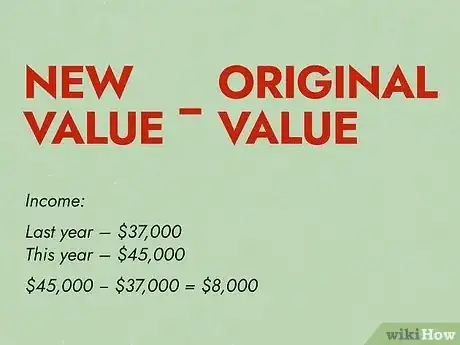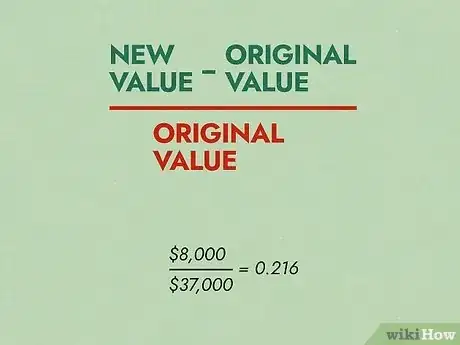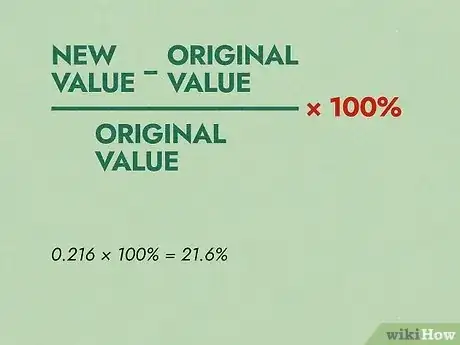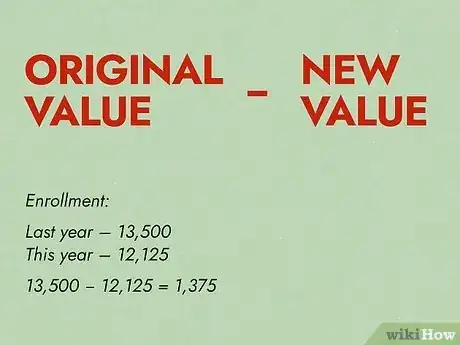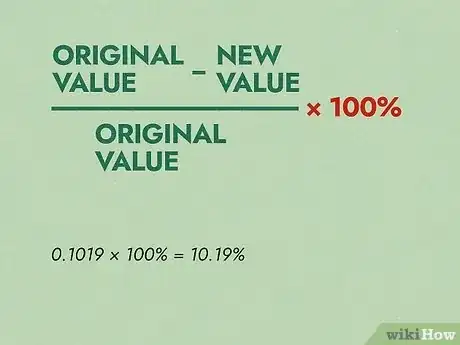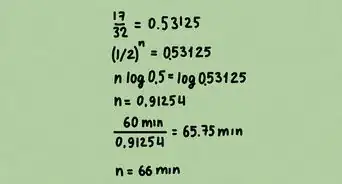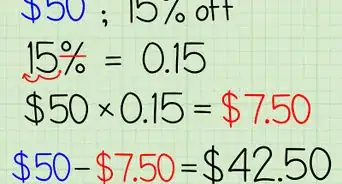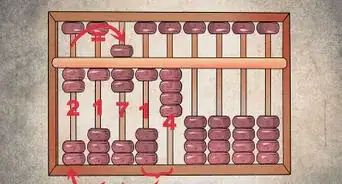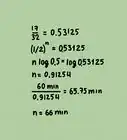This article was co-authored by Grace Imson, MA and by wikiHow staff writer, Sophia Latorre. Grace Imson is a math teacher with over 40 years of teaching experience. Grace is currently a math instructor at the City College of San Francisco and was previously in the Math Department at Saint Louis University. She has taught math at the elementary, middle, high school, and college levels. She has an MA in Education, specializing in Administration and Supervision from Saint Louis University.
This article has been viewed 643,254 times.
In mathematics, the concept of percent change is used to describe the relationship between an old value and new value. Specifically, the percent change expresses the difference between the old and new values as a percentage of the old value. Use the equation ((V2 - V1) / V1) × 100, in which V1 represents an old or initial value and V2 represents the new or current value. If the number is positive, it indicates a percent increase and if it’s negative, it indicates a percent decrease. You can also use a modified formula to determine percent decrease rather than working with negative numbers.
Steps
Sample Percent Change Calculator
Using the Standard Equation
-
1Subtract the original value from the new value. When calculating percent increase, the smaller number is the original (or old) value and the bigger number is the new (or final) value. The opposite is true when calculating percent decrease. You can use this formula to calculate either percent increase or percent decrease. If your answer is a negative number, rather than a positive one, then you know the percent change is a decrease[1]
- For example, say you’re trying to figure out how much your income increased from one year to the next. If you made $37,000 last year and $45,000 this year, subtract 37,000 from 45,000, which is 8,000.
- Alternatively, in the world of retail, when a product receives a discount, this is often expressed as the product being “x% off” which is a percent decrease. If a pair of pants was previously sold for $50 and is now sold for $30, $50 is the original value and $30 is the new value. To start, subtract $50 from $30, which is -$20.
Tip: When dealing with variables with more than one change in value, find the percent change only for the two values you wish to compare.
-
2Divide your answer by the original value. After finding the difference between the numbers, divide that number by the original value, which is the smaller number if the percent increased or the bigger number if the percent decreased.[2]
- Continuing the example, divide 8,000 (the difference between your incomes) by 37,000 (which is the original value). The answer is 0.216.
- Alternatively, dividing the difference (-$20) by the old value ($50) is -0.40. Another way of thinking of this is that the $20 change in value is 0.40 of the $50 starting point, and that the change of value was in the negative direction.
Advertisement -
3Multiply your answer by 100. To turn your answer into a percentage, all you have to do is multiply it by 100.[3]
- Take 0.216 and multiply it by 100. In this case, the answer is 21.6, so your income increased by 21.6%.
- Alternatively, to get the final percentage, multiply the decimal answer (-0.40) by 100. -0.40 × 100 = -40%. This means that the new price of $30 for the pants is 40% less than the old price of $50. In other words, the pants are 40% off. Another way to think of this is that the $20 difference in price is 40% of the initial price of $50. Since this price difference results in a lower final price, give it a negative sign.
Calculating Percent Decrease in an Alternative Way
-
1Subtract the new value from the original value. To calculate percent decrease using this formula, subtract the smaller number (the new or final value) from the bigger number (the original or old value). Note that this is the opposite of finding percent change using the standard equation.[4]
- For instance, say you’re trying to figure out how much a school’s enrollment changed between years. If the enrollment for this year is 12,125 and it was 13,500 last year, take 12,125 away from 13,500, which is 1,375.
-
2Divide your answer by the original value. Remember that when determining percent decrease, the original value is the bigger number.[5]
- In this case, divide 1,375 (the difference between the numbers) by 13,500 (the original value), which is equal to 0.1019 (when rounded).
-
3Multiply your answer by 100. Converting your answer from a decimal to a percentage is easy—just multiply the value by 100.[6]
- Multiply 00.1019 by 100, which is 10.19. So, enrollment decreased by 10.19%.
Tip: If you use this equation and end up with a negative number, it represents a percent increase.
Community Q&A
-
QuestionWhat is the percent of change from 1/4 to 1/2?
 Community AnswerSay you were asked to find the change from 0.25 to 0.5, you would say that it got doubled. In percentage form, this equates to 100%.
Community AnswerSay you were asked to find the change from 0.25 to 0.5, you would say that it got doubled. In percentage form, this equates to 100%. -
QuestionHow do I calculate percent change when the original number is zero?
 DonaganTop AnswererThat is an "undefined" situation, because any percentage of zero is zero.
DonaganTop AnswererThat is an "undefined" situation, because any percentage of zero is zero. -
QuestionHow do I calculate percent change when $40 becomes $30?
 Community AnswerFirst find the difference by subtracting. 40 - 30 = 10. Then divide the result by the original number. 10/40 = 0.25. Then multiply by 100. 0.25 x 100 = 25%.
Community AnswerFirst find the difference by subtracting. 40 - 30 = 10. Then divide the result by the original number. 10/40 = 0.25. Then multiply by 100. 0.25 x 100 = 25%.
References
- ↑ https://sciencing.com/do-out-percent-number-5402624.html
- ↑ https://www.mathsisfun.com/numbers/percentage-change.html
- ↑ https://sciencing.com/do-out-percent-number-5402624.html
- ↑ https://www.omnicalculator.com/math/percentage-decrease
- ↑ https://www.calculatorsoup.com/calculators/algebra/percentage-decrease-calculator.php
- ↑ https://www.calculatorsoup.com/calculators/algebra/percentage-decrease-calculator.php
About This Article
To calculate percent change, start by determining both the old and new values for the amount that has changed. Next, subtract the old value from the new value. Then, divide the answer by the old value. Finally, multiply that number by 100 to get the percent change. For example, if the original value of something was 30 and then went up to 50, you would subtract 30 from 50 to get 20. Then, you would divide 20 by 30 and get 0.033. Finally, multiply that by 100 to get a final answer of 33 percent. For tips on how to find the percent change when there are more than two values, read on.

